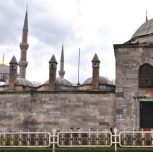Külliye (mosque complex) is a group of structures built around a mosque under a legal entity of endowment or foundation (in Turkish, vakıf). These charity organizations were established by the imperial family, high-level state dignitaries or wealthy people. The goal was for the fund to last indefinitely.
They were a self-supporting system in which the income of some operations are used to sustain the main purpose of the külliye. Thus, most of the külliyes had to have a revenue producing commercial operation. Mosques, schools, hospitals, caravansaries, hospices, public kitchens, fountains, and mausoleums are among components of the külliyes.
According to the archive records of the Directorate General of Foundations, the first known Foundation in Anatolia was set up in 1048, and tens of thousands of foundations were set up in the Seljuk and Ottoman territories.
The Church of Pantokrator in Istanbul (today, Zeyrek Mosque) was founded by John II Komnenos and Empress Eirene in 1118-1136. It was designed to serve as a religious and social complex serving also as an imperial funeral chapel for the Komnenos dynasty. With its two churches, a hospital, a nursing home, baths and a library, it operated under an Imperial Foundation. The rules and regulations of the foundation were recorded on the typikon of the monastery, which are the only remaining Byzantine monastic foundation documents inherited today. The typikon of the monastery created an autonomous institution, which was independent of the patriarch or the prefect of the city. The rich endowment was also exempt from taxes. The typikon of the monastery in the Orthodox Christian Church is a book of directives illuminating social and religious functions in the monastery. The original typikon of the Church of Pantokrator was issued in 1136.
The Divriği Great Mosque and Hospital (Dârüşşifâ) complex in Sivas was built in 1228-1229, and The Kayseri Kölük Mosque, School (medrese) and Bath (hamam), built in 1135 -1142, are remaining examples of the early külliyes established in Anatolia by Seljuks.
Orhan Gazi Külliyesi was built in İznik (Nicaea) in 1334, the first külliye established by Ottomans in Anatolia. After the conquest of Istanbul, Sultan Mehmed II converted the church of Hagia Sophia into a mosque, and by adding some revenue producing operations he created a külliye. Mehmed II also established his own külliye, which became the largest külliye of the Ottomans. It was called Fatih Külliyesi, named after Mehmed Fatih, “the Conqueror”.
In parallel with the thriving financial position of the empire, 16th century became the top period for the construction of külliyes. This century also had a genius engineer, named Sinan the Architect. Selimiye Külliyesi (1569-1575) in Edirne and Süleymaniye Külliyesi (1550-1557) in Istanbul were the best examples of Sinan’s masterpiece works.
Sultanahmet Külliyesi (1609-1620) and Yeni Cami (New Mosque) Külliyesi are among the best külliyes built in the 17th century.
Ahmet Vefa Çobanoğlu, (2002), “Sultanahmet Camii ve Külliyesi”, TDV Isam Ansiklopedisi. Cilt.26, p.542-544
Directorate General of Foundations, (TC Vakıflar Genel Müdürlüğü), http://www.vgm.gov.tr/sayfa.aspx?Id=78
Translated by Robert Jordan, (2000), “A Complete Translation of the Surviving Founders’ Typika and Testaments”, Dumbarton Oaks, Washington, D.C.










